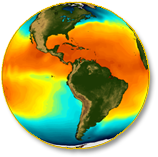Projects underway to slow or stop Climate Change  Concepts
Concepts
Mitigation and Adaptation
|
The IPCC defines mitigation as: "An anthropogenic intervention to reduce the sources or enhance the sinks of greenhouse gases." The IPCC defines adaptation as the "adjustment in natural or human systems to a new or changing environment". The more we can mitigate climate change, the less we'll have to adapt. |
|
|
California Mitigation Efforts |
|
| The state of California is a national leader in carbon mitigation efforts. In 2006 California passed the Global Warming Solutions Act requiring a 25 percent reduction in state CO2 emissions by 2020. California also has a Renewable Energy Portfolio Standard requiring electric corporations to supply 20% of the electricity they provide from renewable resources, and the Low Carbon Fuel Standard which requires a reduction of at least 10 percent in the carbon intensity of California's transportation fuels by 2020.In May 2015, California initiated a first-of-its-kind agreement with international leaders from 11 other states and provinces, to limit the increase in global average temperature to below 2 degrees Celsius. If the signatories represented a single country, it would be the second largest economy in the world, behind the United States. Learn more about California's Climate Change Program. |
 |
Western Climate Initiative |
|
 |
The Western Climate Initiative (WCI) is a collaboration of independent jurisdictions working together to mitigate climate change at a regional level.
The WCI began in 2007 when the Governors of Arizona, California, New Mexico, Oregon, and Washington signed an agreement directing their respective states to develop a regional target for reducing greenhouse gas emissions, participate in a multi-state registry to track and manage greenhouse gas emissions in the region, and develop a market-based program to reach the target.
The Premiers of British Columbia, Manitoba, Ontario, and Quebec, and the Governors of Montana and Utah have since joined the original five states in committing to tackle climate change at a regional level.
Learn more about the Western Climate Initiative Program. |
|
The Wisconsin Initiative on Climate Change Impacts (WICCI) |
|
 | |
WICCI is a statewide collaboration that brings scientists and stakeholders together to develop climate change adaptation strategies. WICCI began as a partnership between the UW-Madison and the Wisconsin Department of Natural Resources and has grown to include participants from many other state agencies and institutions. WICCI is designed to investigate potential climate change impacts on specific natural resources, ecosystems, economic activities, and regions. It evaluates risks and vulnerabilities in each of these areas and helps develop strategies for adaptation that can be used in decision making, development, public health, and other critical aspects that affect the quality of life and sense of place in Wisconsin. Learn more about WICCI. |
|
|
Climate Action Plans |
This map shows U.S. states with Climate Action Plans to mitigate climate change as of 2024. |
|
Climate Action Plans detail steps individual states can take to reduce their overall carbon footprint. The process of developing a climate action plan can identify cost-effective opportunities to reduce GHG emissions that are relevant to the state. Unique characteristics of each state's economy, resource base, and political structure provide different opportunities for combating climate change. Along with reducing sources or enhancing sinks of greenhouse gases, these plans seek to identify co-benefits such as improved public health and expanded economic opportunities available while mitigating climate change. Learn more about Climate Action Plans | |
|
Project Drawdown |
|
| Project Drawdown is a comprehensive plan to reverse global warming. It consists of 100 responses to climate change: 80 existing solutions and 20 proposed scenarios. The project provides a path forward to roll back (drawdown) global greenhouse gas emissions within thirty years. The research revealed that humanity has the means and techniques at hand for 80 of the solutions! And 20 more are already being pursued, but not yet fully developed. Below is a list of the top ten solutions, note that reducing food waste is third on the list, something everyone can do without cost or hardship. | |
|
Learn more about Project Drawdown | |

